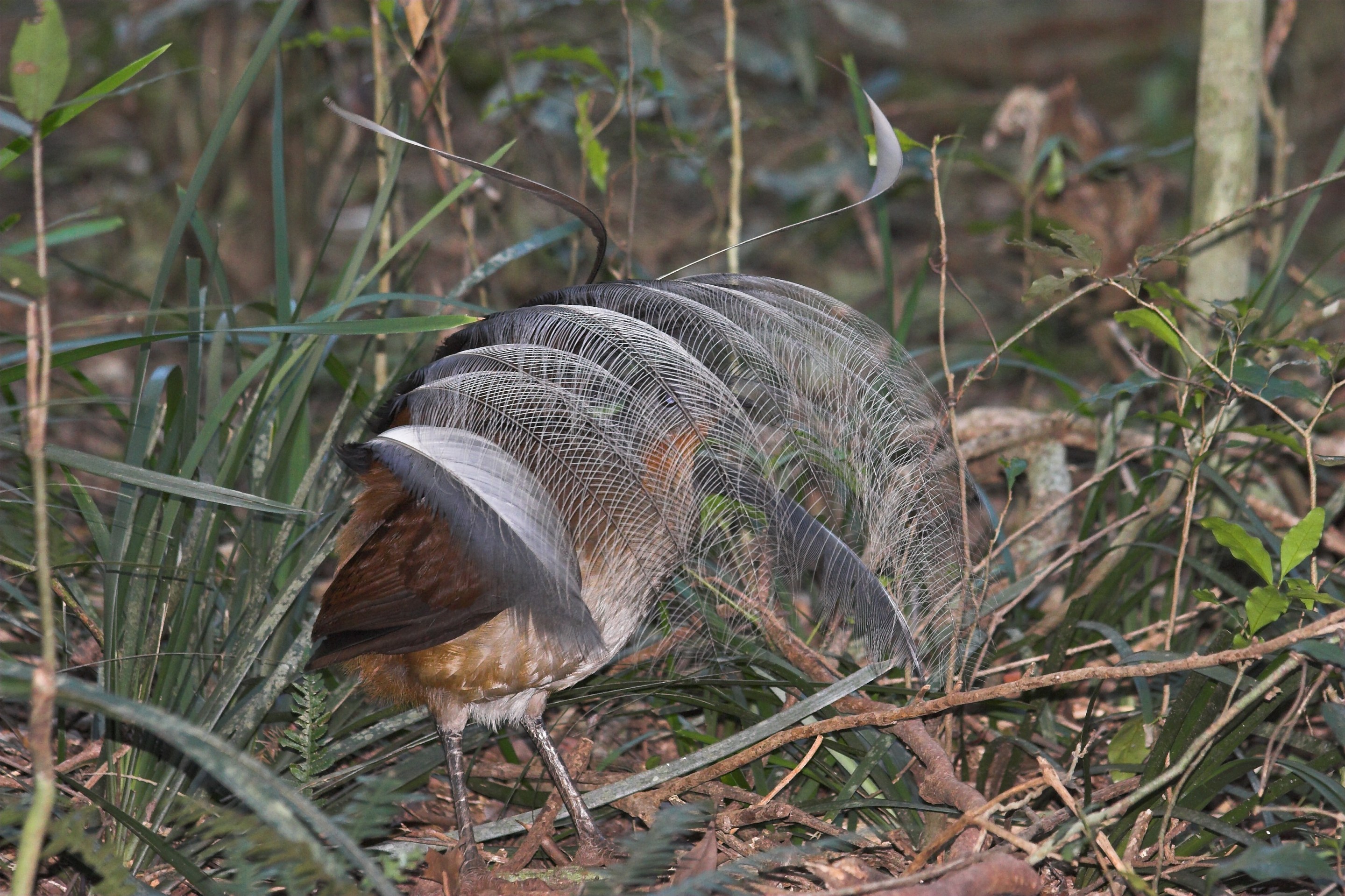Albert's lyrebirds are auburn-colored ground-dwellers that spend their days nosing around the Australian forest floor for tasty bugs and mimicking the calls of other birds (maybe they should call them liarbirds, ha ha). Lyrebirds are notoriously shy, but the males are unapologetic showmen when they want to mate. When a lyrebird wants to woo, he busts out an elaborate courtship dance on a stage of his own preparation. He flips his silvery lattice of tail feathers over his head like a bridal veil, revealing the bright orange feathers beneath. And then he breaks out in an elaborate song, which does not mimic any other bird but is entirely his own.
"If a female comes to his display platform, that's when he'll transition into his gronking song, which is his dance song," said Fiona Backhouse, an acoustic and spatial ecologist at the Cornell Lab of Ornithology. Male Albert's lyrebirds have two gronking songs: a loud gronking song that sounds like "gronk gronk gronk" with some crackling noises interspersed, and a rhythmic gronking song with a recognizable beat. Males will alternate between these two gronking songs until his potential mate chooses to join him, or walk away. And if all this gronking were not enough, the males dance in sync with their songs, shaking the trampled vines and branches that comprise their dancing platform. Backhouse and colleagues described the stage-shaking choreography of the birds' gronking dances in a paper recently published in The American Naturalist.
"I enjoyed the paper so much," said Nao Ota, a behavioral biologist at the Museum of Nature and Human Activities in Hyogo, Japan, who was not involved with the research. "Their behavior is intriguing in discussing both animal tool use and the complexity of communication behavior," she added.
In the 1970s, the naturalist Sidney Curtis first suggested the lyrebirds might rhythmically shake their stages after noticing the trampled vines looked weathered, as if the birds frequently clutched them in the same spot. But the behavior was nearly impossible to track down in the wild, given the elusive nature of the dancers. "Most lyrebirds, if they know you're there, they'll disappear," Backhouse said.
Decades later, an Albert's lyrebird named George brought gronking out of the shadows. George lived in the rainforests of Lamington National Park, near a resort where visitors can stay to encounter plants and wildlife. Glen Threlfo, a naturalist who worked at the resort, noticed George had become accustomed to people. "He would actually dance while people were nearby," Backhouse said. The nature photographer Michael Snedic, who was lucky enough to watch George dance, wrote that the bird tugged the vines of his platform "so ferociously that the surrounding palm lilies and lilly-pillies shook with him." Backhouse never got to see George, as the lyrebird died a few years before she started studying the species. But George's unusual familiarity with people gave scientists rare insight into his extremely shy species.
Backhouse had previously researched the vocalizations of Albert's lyrebirds but had been interested in Curtis's observation of the stage-shaking. She wanted to film their dances to learn more about this behavior—if it was unique to George or found across the species. To track down the secretive birds, Backhouse drove around the park to areas where Albert's lyrebirds had been recorded and wandered around until she heard their calls. She also drove with her windows down, pulling over if she heard one and then following the call into the forest.
The bird's stages were not easy to spot. Albert's lyrebirds prefer the vines of a plant called wait-a-while or lawyer cane, which entangles other plants (and hikers, which explains its nickname) with its spines. "These vines are attached to everything else in the forest, and so if they shake the vine, all this other vegetation moves as well," Backhouse said. She kept her eyes out for little trampled patches of the vine in the rainforest, looking for clues like feathers or worn-down spines. After locating what she suspected was a nest, Backhouse set up autonomous sound recorders and motion-sensor cameras programmed to record in the mornings.
The researchers filmed the gronking dances in five populations of Albert's lyrebirds. Although some birds used sticks instead of vines, all the recorded males shook their stages, suggesting the trait is seen across the species (although the populations varied a bit in their tempo). And whenever the male birds were performing rhythmic gronking, they synchronized the beat of their song with the beat of their shaking, confirming prior observations. "They clearly coordinated their vocalization with stage-shaking movements," Ota said. She added that she was curious to know how much the birds had manipulated their stage, such as if they adjusted the position or amount of plants on their stage before shaking it.
Other birds manipulate their environment during communication, constructing stages or using props. Palm cockatoos drum on trees using sticks and woodpeckers drum on trees with their bills. Small blue songbirds called cordon-bleus, which Ota studies, shake a branch to perform a "tap-dance" display during courtship. The authors suggest the Albert's lyrebirds' gronking performance might arguably be considered music. "The fact that these birds are synchronizing these display movements or dance movements with their songs sort of draws another parallel with human music," Backhouse said.
There were no female lyrebirds in the new footage, leaving their opinion of the specifics of each gronking display a bit of a mystery. If this shaking behavior is effective, male birds that produce louder sounds or create bigger shakes might have more mating options, or even shoo rival males away, Ota said. "Answering these questions would provide significant insights into the functions and evolution of animal communication systems," she added.
The shaking display offers the male birds a chance to create a big bodily impression, almost like a cat puffing up its fur. "I think by moving this vegetation, there's not only a visual spectacle of the bird himself but from all the vegetation around him," Backhouse said. "I think it's a way of making him look really impressive to a watching female." But there are other possibilities, such as creating an illusion that a dangerous predator lurks behind the stage to ensure the female does not flee the scene. To answer these questions, "we need to go out and get more footage of this behavior with females present," Backhouse said. With any luck, the coming years will bring in a Georgina.





